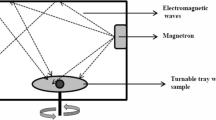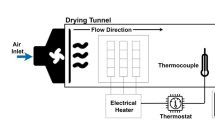Abstract
Frozen potato puree samples were tempered using an ohmic heating technique. Three salt concentrations (0.50, 0.75, and 1.00 %) and three frequency levels (10, 20, and 30 kHz) were used as experimental variables, and the effects of salt concentration and frequency on ohmic tempering were investigated. Temperature, electrical current, and voltage were measured during the ohmic tempering. Electrical conductivities were evaluated based on the sample geometry and the ohmic heating principle. Increasing the salt concentration and/or frequency increased the electrical conductivity and heating rate, and hence contributed to decreasing the tempering time for the frozen potato puree samples. The tempering time was lowest with the highest salt concentration employed, and longest for the lowest salt concentration and frequency. Temperature differences within the sample during ohmic heating were found to be lowest when employing 0.50 % salt concentration and 10 kHz frequency.




Similar content being viewed by others
References
Bozkurt, H., & İcier, F. (2012). Ohmic thawing of frozen beef cuts. Journal of Food Process Engineering, 35(1), 16–36.
Clements, R.A. (2006). Development of an ohmic thawing apparatus for accurate measurement of electrical resistance. Ph.D. Thesis. University of Florida, Gainesville, FL, USA.
Farag, K. W., Lyng, J. G., Morgan, D. J., & Cronin, D. A. (2011). A comparison of conventional and radio frequency thawing of beef meats: effect of product temperature distribution. Food & Bioprocess Technology, 4, 1128–1136.
Halden, K., De Alwis, A. A. P., & Fryer, P. J. (1990). Changes in electrical conductivity of foods during ohmic heating. International Journal of Food Science and Technology, 25, 9–25.
Icier, F., Izzetoglu, G. T., Bozkurt, H., & Ober, A. (2010). Effects of ohmic thawing on histological and textural properties of beef cuts. Journal of Food Engineering, 99, 360–365.
James, S. J. (1999). Food refrigeration and thermal processing at Langford, UK: 32 years of research. Trans Institution of Chemical Engineers, 77(C), 261–280.
James, S. J., & James, C. (2002). Meat refrigeration. Cambridge, UK: Woodhead Publishing Ltd.
Li, B., & Sun, D. W. (2002). Novel methods for rapid freezing and thawing of foods—a review. Journal of Food Engineering, 54, 175–182.
Lima, M., Heskitt, B. F., & Sastry, S. K. (1999). The effect of frequency and wave form on the electrical conductivity-temperature profiles of turnip tissue. Journal of Food Process Engineering, 22, 41–54.
Miao, Y., Chen, J. Y., & Noguchi, A. (2007). Studies on the ohmic thawing of frozen surimi. Food Science and Technology Research, 13(4), 296–300.
Naveh, D., Kopelman, I. J., & Mizrahi, S. (1983). Electroconductive thawing by liquid contact. Journal of Food Technology, 18, 171–176.
Norton, T., & Sun, D.-W. (2008). Recent advances in the use of high pressure as an effective processing technique in the food industry. Food and Bioprocess Technology, 1(1), 2–34.
Palaniappan, S., & Sastry, S. K. (1991). Electrical conductivity of selected juices: influences of temperature, solids content, applied voltage, and particle size. Journal of Food Process Engineering, 14, 247–260.
Roberts, J. S., Balaban, M. O., Zimmerman, R., & Luzuriaga, D. (1998). Design and testing of a prototype ohmic thawing unit. Computers and Electronics in Agriculture, 19, 211–222.
Sastry, S. K., & Li, Q. (1996). Modeling the ohmic heating of foods. Food Technology, 50(5), 246–248.
Sastry, S. K., Jun, S., Somavat, R., Samaranayake, C., Yousef, A., & Pandit, R. B. (2009). Heating and sterilization technology for long-duration space missions. Annals of the New York Academy of Science, 1161, 562–569.
Singh, S. P., Tarsikka, P. S., & Singh, H. (2008). Study on viscosity and electrical conductivity of fruit juices. Journal of Food Science and Technology-Mysore, 45(4), 371–372.
Varghese, K. S., Pandey, M. C., Radhakrishna, K., & Bawa, A. S. (2012). Technology, applications and modelling of ohmic heating: a review. Journal of Food Science and Technology. doi:10.1007/s13197-012-0710-3.
Author information
Authors and Affiliations
Corresponding author
Rights and permissions
About this article
Cite this article
Seyhun, N., Ramaswamy, H.S., Zhu, S. et al. Ohmic Tempering of Frozen Potato Puree. Food Bioprocess Technol 6, 3200–3205 (2013). https://doi.org/10.1007/s11947-012-1002-7
Received:
Accepted:
Published:
Issue Date:
DOI: https://doi.org/10.1007/s11947-012-1002-7




